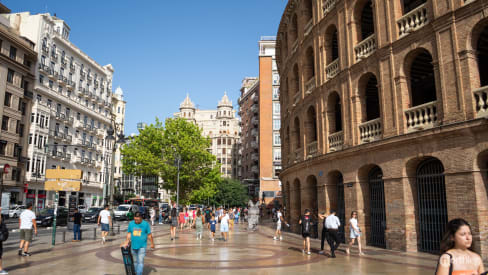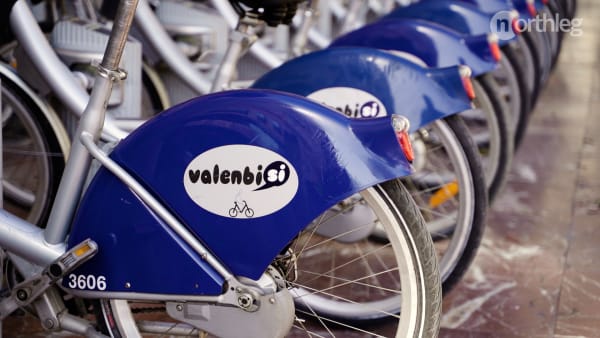Location and how to get there
Location and how to get there
The Plaza de Toros is in a very easy-to-reach position, just at the edge of the old quarters of the city, next to the Nord train station. Because of its location, it is also very close to many other important sights.
Location
Valencia’s Plaça de Bous is located just outside Valencia’s old city walls.
It is immediately east of the city’s main train station, Estación del Norte, where the Old Town (to the north of the Bullring) meets the newer neighbourhoods (to the south), like the Eixample.
The stadium is enclosed by Calle de Xàtiva to the north (the street that passes in front of the train and metro station), Carrer d’Alacant to the west, and Calle de Castelló to the south.
How to get there
As the Bullring stands on the line between the old quarters and other neighbourhoods of the city, chances are you will pass by it or have already done so, whether you are walking or taking a bike.
If you are in a different part of the city, you might want to take public transport.
By metro/tram
The Plaça de Bous is in a great position to be reached by metro and tram, as there are various stops nearby. Depending on where you are located, one or the other might be more convenient.
The closest stations are:
- Xàtiva (view map), the metro stop just next to the Bullring, directly in front of the main train station.
- Colón (view map), a metro stop northeast of the Bullring.
- Alacant (view map), the tram stop right between the train station and the Bullring.
Xàtiva is only 1 minute away from the Bullring, while Colón is 600 m away (7-minute walk, a little under 0.4 miles) from it. The same three lines (3, 5, 9) stop at both stations.
The tram network’s line 10 stop, Alacant, is to the side of the building.
For detailed information about how this system works, you can read our article about the metro and trams in Valencia.
By bus
The Bullring is close to both Estación del Norte and Plaza del Ayuntamiento, both key points in the urban bus network, so there are are quite a few buses stopping right by it.
The closest bus stop is probably Estació del Nord, directly in front of the Bullring. To reach the entrance from the bus stop you’ll only need to walk about 1 minute (50 m, 164 feet).
The other stop is Xàtiva, a little down the street to the west, but still very close (200 m, about 0.1 mile). You’ll find other stops all around the train station area, but these two are the ones with the most lines.
For detailed information about tickets and how to get them, you can read our article about buses in Valencia.
| Line |
|---|
| Stop |
| Details |
| Line | C1 | 6 | 7 | 8 | 11 | 19 | 28 | 35 | 40 | 70 | 71 | 73 |
|---|---|---|---|---|---|---|---|---|---|---|---|---|
| Stop | Xàtiva | Estació del Nord | Xàtiva | Estació del Nord | Xàtiva | Estació del Nord | Xàtiva | Estació del Nord | Estació del Nord | Xàtiva | Xàtiva | Xàtiva |
| Details | It is a circular line that runs the length of the old city walls, hugging the old quarters of the city. Some of its stops are Puerta de la Mar, Plaza del Ayuntamiento, Xátiva, Torres dels Serrans. | This line crosses the city north to south, making quite a few stops in the western part of the city and along the TuriaPark. | This line connects the south-western part of the Old Town with other southern neighbourhoods of Valencia, like Chinatown, the area surrounding the two train stations, and Russafa. | This is a line that dwells mostly in the southern and western parts of the city centre, around the two train stations and the Ruzafa neighbourhood. | This line crosses Valencia’s urban area from southwest to northeast. On its route, it stops by some important spots, like the Plaza del Ayuntamiento, Estación del Norte, Colón, and the TuriaPark. | It connects the central areas aroundPlaza del Ayuntamiento and Xátiva to the seaside, stopping by the Cabanyal neighbourhood, and near Les Arenes and Malvarosa beach. | This line runs the entire length of the old city walls, circumscribing the old quarters of the city. It also goes into the neighbourhoods north of the centre for a stretch. | It connects themain train station, the Plaza del Ayuntamiento, and theEixample with the neighbourhoods that stand between the city and its beaches. | This line connects the southeastern part of the Old Town and theEixample with the Blasco Ibáñez area. | This line connects the western areas of the city with the southern areas of the Old Town, and then proceeds towards the northeast of the city. | This line crosses the city west to east. On its route, it passes by the main train station, Colón, the Turia Park and the Blasco Ibáñez area. | This line dwells mostly in the western part of the city, connecting the Old Town with neighbourhoods like l’Olivereta and Sant Isidre. |
By taxi
Cabs are obviously the most expensive option to move around the city, and they might not always be the most comfortable way to get to your destination.
As the Plaça de Bous is so well connected, we would recommend this means of transport if your departure point is not close to any form of public transport, maybe in the outskirts of the city.
In any case, it is normally quite easy to hail a taxi in the street in Valencia, but other options are also booking through a mobile app or through a phone call.
See detailed information on this in our article about taxis in Valencia.
By bike
Valencia is a very bike-friendly city, so we always recommend exploring it this way.
On the official map , you’ll see that there are bike paths circling the city’s old quarters. You can also cycle in the city centre and its pedestrian zones, as long as there is enough room for people to walk.
On the same map, you will also see that there are two Valenbisi stations by the Bullring. One is right in front of it, the other one is a little further down the street, in front of the train station. Many other Valenbisi stations are also not far away.
If you want to know more about cycling in the city, read our article about biking in Valencia or our article about Valenbisi, Valencia’s public bike rental service (with video guides).
By scooter
Electric scooters are an ever-more popular transport solution in Valencia. They are ideal if you want to move independently around the city and you don’t want to get stuck in traffic, but you don’t like cycling or walking. Many scooter-sharing companies offer rental plans that let you pay per minute of use and nothing else.
You can park and drive your scooter within a designated area in the city’s urban zone. Generally, you are not allowed to park throughout most of the old quarters of the city. Luckily for you, the Bullring is just outside that no-park zone, so you’ll be able to park your scooter just by it.
If you want to know more about this, you can check out our article about electric scooter rentals in Valencia. In the article, you’ll find step-by-step instructions and video guides to help you through the rental process.
On foot
Given that Plaza de Toros is in such a visible spot, it is normal that reaching it on foot is not difficult at all, so if you are in the Old Town, going on foot is the easiest option. In fact, it is likely that you will pass by it when going from the older historical quarters of the city to the newer ones, like the Eixample.
From Plaza del Ayuntamiento, located in the old quarters of the city, you’ll only have to walk 300 m (4-minute walk, a little under 0.2 mile). To reach your destination, simply walk along Avenida del Marqués de Sotelo.
The Serranos towers, at the opposite end of the centre (the northern edge), are 1.5 km (about 0.9 miles) away. You could, for example, take a short walk (about 18 minutes) and cross the entire city centre to go from one point to the other.
If you’d like to explore Valencia on foot, we have created a selection of self-guided walking tours that you can enjoy at your own pace. You can find the one that best fits your needs on the Northleg itineraries section.





















